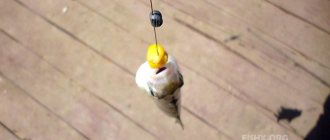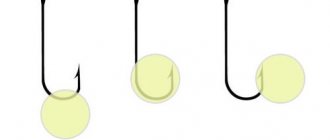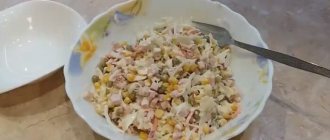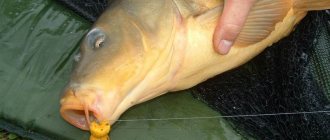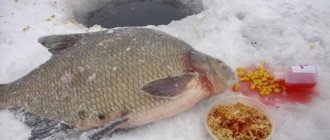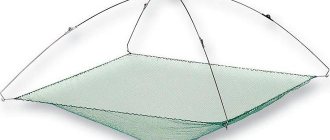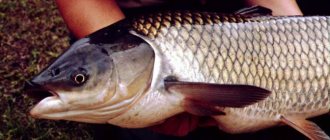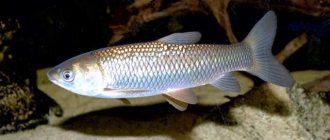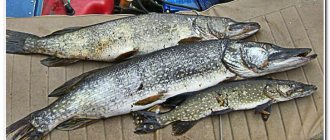Does crucian carp bite on corn?
Experienced fishermen believe that catching a clumsy crucian carp is not difficult. Some, on the contrary, are sure that this fish is not so catchy. Over the years, a huge number of different techniques for catching crucian carp have been invented. You need to choose them depending on the time of year and fishing location.
In summer, fishing for crucian carp is considered more successful, because the prey is in constant search of food. This plant product can be used when fishing with a float rod, feeder and bottom gear.
It is only possible to fully understand whether crucian carp bites on such bait through practical means.
Corn for feeding
As part of the bait, corn grains act on fish like a magnet. They are added to any store-bought or home-prepared bait mixture. The broth remaining after cooking should also be poured into the bait to moisturize and create a fragrant trail. It is important here not to overdo it with quantity. Reasonable proportions: 300 g of boiled corn per 2 kg of mixture. By the way, this is quite enough for fishing if only float rods are used.
Corn for the mixture is prepared in the same way as other grains. It is better to cook a little longer so that the grains are more boiled. These will hold both in the feeder and in the ball when casting by hand.
Advice: use only fresh corn, as sour grains can have the opposite effect.
Bait selection
When going fishing, you can buy ready-made raw materials for bait, which are sold in a jar. It is also possible to use special bait grains produced by companies specializing in the production of fishing products. If necessary, you can cook corn at home using different methods. You have the opportunity to choose the one that is right for you.
Did you know? The Mayan Indians believed that corn was a divine plant. Therefore, they worshiped his deity - Ah Mun.
Canned
Beginning fishermen prefer to use ordinary canned corn as bait, which is sold in any store. All manufacturers of canned vegetables have almost identical products and differ only in price. It is recommended to buy several cans at once, from different manufacturers. First of all, take a closer look at the density of the grains. They should not be too hard or soft. Only large and medium-sized grains are suitable for fishing.
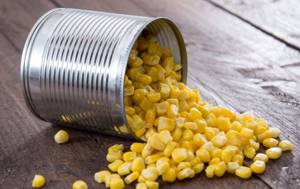
Experienced fishermen advise pre-cutting large grains into two parts. This way the aroma of corn will be more pronounced and the bite will be plentiful. If you decide to place the halves on the gear, it is better to do it with the cut outward. When the grains are selected, divide them into two piles, distributing them into different small containers. Add a small amount of sunflower oil, preferably unrefined, to one of them, and freshly squeezed dill juice to the other.
Important! Try to be as quiet as possible when fishing so as not to scare away the wary crucian carp and thereby increase your catch.
Boiled
If you don’t want to spend money and time searching for high-quality canned corn, you can prepare the product yourself. This will also allow you to use it for baiting fish. First of all, you should soak the grains in clean warm water so that they swell a little. You need to keep it in this state for at least 20 hours.
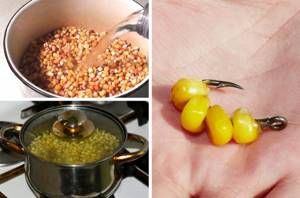
If you do not insist enough, the dense grains will swell inside the caught crucian carp, which will lead to rupture of its insides and a deterioration in the taste of the catch. When the grains become a little softer, you need to boil them in lightly salted water. Cooking time: 40 minutes. If desired, you can add various flavors to increase the chances of catching large crucian carp.
Did you know? There is always an even number of seeds on an ear of corn.
Artificial
Very often, anglers use artificial corn - a silicone-based bait. In fact, this is an unnatural empty grain (shell), into which various flavorings are pumped in to help activate the bite.
- Advantages of artificial bait:
- reusable;
- no need for preliminary preparation;
- effectiveness in attracting crucian carp.
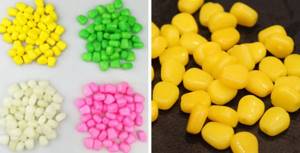
How to use young corn?
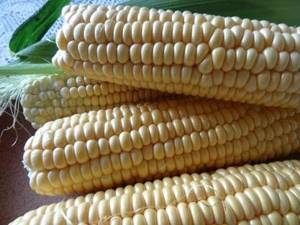
You can prepare corn for fishing in the summer if you miss the moment of ripening of the heads of this crop. Young grains contain large amounts of lactic acid, and they have such a bright and characteristic aroma and taste. These grains are suitable in their raw form for fishing for carp, silver carp and in some reservoirs for carp. When the grains are slightly ripe, they are boiled.
How to cook corn for fishing? Exactly the same as for yourself. You need to choose heads of cabbage with slightly yellowish, but already juicy and large grains and cook until bright yellow. We make sure that the grains are of the correct shape and soft. Pour water into the pan and put the heads of cabbage there when it boils. One small head of cabbage is enough for fishing. Feel free to cook the rest for yourself. This is a high-calorie food that will completely replace any breakfast and lunch, especially when fishing, when you don’t want to be distracted by cooking.
Cook the corn for about 30 minutes. If the cobs are young, then 20, if slightly overripe, then 40. The period of young corn begins in July and ends in mid-August. Of course, we salt the finished product for ourselves, but we don’t do this for fish. The smell and taste of young corn will suit carp and grass carp quite well.
This bait is good for catching carp, crucian carp, bream, and roach. It holds well on a hair montage and just on the hook.
How to prepare corn for fishing
To prepare dry grains for subsequent use, follow these instructions:
- Soak the plant material for 1–3 days in warm water. Change the liquid every day to prevent it from going sour.
- Boil the grains for 40–60 minutes after boiling.
- Leave the corn in the water for another 24 hours.
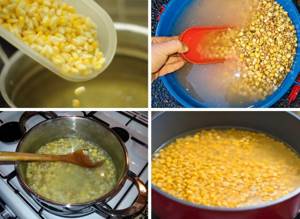
Add flavoring (smoked meat, dill, etc.) to the water. The grains will be saturated with odors, and this will help the fish bite better.
Familiarize yourself with the features of catching carp in September.
Types of corn for crucian carp
There are several varieties of corn kernels. It is not immediately possible for a beginner to figure out which type of attachment to give preference to in specific situations. The main variations of this bait are:
- canned corn;
- boiled corn;
- artificial corn;
- fermented corn
Canned
Canned corn grains are most readily available to fishermen today. They can be purchased at any grocery store. The cost differs depending on the manufacturer, but does not exceed reasonable limits and is affordable for every fisherman. Another advantage of this type of bait is its strength, it “sits” well on the hook, and small things cannot knock the bait down.
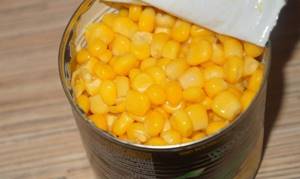
It is difficult to recommend something specific among certain brands of canned corn. Although there is a common belief among anglers that bonduelle corn is a good option, there is not much difference.
The cooking technology is almost the same for everyone and the brand does not matter.
Boiled
Boiled corn is no less effective than canned corn. It is used when it is necessary to obtain grains of a given consistency and in cases where this bait is used in groundbait. The recipe for its preparation is as follows:
- Corn cobs are placed in a pan and filled with water.
- The corn is soaked for about a day.
- Then it should be boiled for 30–40 minutes.
- If necessary, flavoring is added during or after cooking.
- All that remains is to cool the nozzle and you can go to the pond.
The corn kernels should be soft. If you overcook it, the bait will easily fly off the hook. Crucian carp take bait that is too hard and worse.
It’s a good idea to add sugar and salt during cooking, which will fully reveal the aroma that is attractive to the fish.
Artificial
Artificial corn is made from silicone. In fact, these are dummies of its grains, made in different colors and impregnated with various flavors.
This attachment is convenient because it does not need to be prepared, it is always at hand and can be stored for a long time. The cost will be more expensive than boiled or canned corn.
Fermented
To obtain a more attractive aroma, corn is fermented. To do this, it is boiled, then transferred to a separate container and filled with water in which it was boiled.
Cover with a lid and leave for 10-12 hours. Fermented corn is used as bait, and the bait is moistened with the remaining water.
How to hook
There are two ways to put corn on a hook, namely:
- for the shell . First, pierce the grain in the upper part, and then pass the tip of the hook under the shell and bring it out;
- through and through Insert the hook into the top and out at the bottom, where the grain opens.
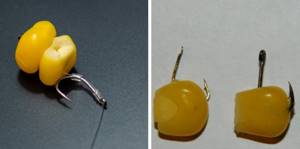
What time of year to catch bream on corn
You can catch bream using corn in the summer, when it is not particularly picky about food and bites with equal success on baits of both plant and animal origin. If you decide to try this product as bait in spring or autumn, try diluting it with bloodworms, maggots or worms. This will greatly increase the fish's interest. Also a little trick would be to soak the corn in different flavorings. For example, in the spring it is better to use the scent of crab, shrimp or garlic for bait, and in the fall - the scent of plum or chocolate.
Fishing techniques and tactics at different times of the year
To catch crucian carp, you will need a large amount of complementary food. Also decide on a fishing spot. It is best to throw gear next to snags, in reservoirs with an uneven bottom or on dumps. Often fish swim into shallow water to get food. At such moments you need to wait for her next to the reeds or reeds.
Important! Crucian carp rarely bites. To increase your chances of a decent catch, cast your gear at dawn.
The place for fishing should be chosen depending on the weather. If it is cool, cloudy or there is a chance of precipitation, the crucian carp will approach shallow water. When summer comes, especially August, this aquatic inhabitant is localized at depth. This is due to the fact that potential prey is trying to hide from the heat.
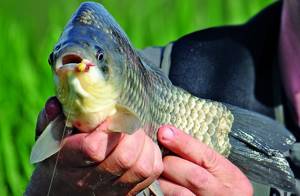
The best catch of large crucian carp occurs when there is a current. It will “revive” the bait without additional movements by the fisherman. The gear needs to be located upstream. If the water flow is very strong, then throw the bait a little lower. This will reduce the likelihood of the line twisting and will allow you to keep the baited hook in one place longer, attracting a predator. It is very difficult to fish in still water. You will have to constantly tug on the fishing rod yourself so that the bait moves, attracting prey.
You will be interested in learning how to catch chub using bottom and feeder gear.
How to choose corn for bait
Most often, fishermen use ordinary canned corn from Bonduelle, which can be purchased at any supermarket, but this is not the best option. It is better to take time and visit a fishing store to purchase a special bait prepared for fishing. Natural aromatic additives are used in the preparation of such plant baits. Fishing will be as successful as possible if you choose options with the following scents:
- vanilla;
- strawberry;
- raspberries;
- garlic;
- hemp.
Do not pour liquid from an open canned product. Experienced fishermen use it to mix bait using breadcrumbs, cake, bran or cereals.
Advantages and disadvantages of fishing with corn
- The advantages of the above process include:
- availability . Corn kernels are sold in stores both in big cities and small towns;
- ease of use. Easy to attach to the hook;
- efficiency . Thanks to its strong aroma, corn actively attracts fish;
- versatility _ With this bait you can catch both large and small crucian carp.
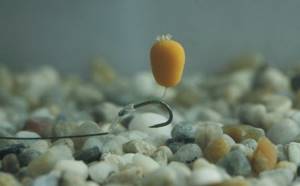
Corn also has a disadvantage as bait. Fortunately, there is only one - the product can slide off the hook. So, now you know what types of corn are most often used for crucian carp fishing. You can buy canned grains at the store or make your own bait at home. Thanks to it, it is possible to catch large fish, which will become a real decoration of the table.
Features of bait
When fishing with corn, as with other baits, the use of bait is necessary. To do this, the cooked grains are divided into two parts.
The first part consists of large grains; they will be used as bait. The second part, much larger in volume - grains that are small and unsuitable for hooking, will form the basis of the bait.
Corn grains intended for bait can be mixed with soil and breadcrumbs. The first component adds heaviness to the mixture, quickly sinking it to the bottom at the desired point in the reservoir, the second “dusts”, attracting the attention of crucian carp.
In addition to the base, boiled or canned corn is often used in bait as an additional component.
Corn as bait
The taste and smell of corn kernels are very tempting for fish, and this is all thanks to the unique chemical composition.
Yellow grains, among other things, contain a lot of vitamin B , which also attracts fish. A separate theme is their bright color - it acts as a visual stimulus. It’s funny, but yellow corn often provokes outright predators, who are never interested in plant baits, to bite.
Why would a perch covet this protein-poor bait? Apparently, color played a decisive role here.
Corn has another very good property - its ability to sift out small things .
Pros and cons of using
To catch crucian carp using corn, a fisherman has several compelling reasons:
- it has an attractive smell, taste and color for crucian carp;
- It is very easy to prepare for fishing. You just have to go to the nearest grocery store. Dry corn can be stored at home for a long time;
- it holds firmly on the hook, thanks to which small fish cannot remove the odorous bait;
- You can add different flavors to this attachment, which gives the fisherman complete freedom of choice;
- by preparing the bait yourself, you can achieve the desired softness of the grains;
- the low cost of the bait contributes to its popularity.
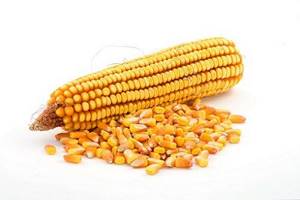
Corn can be combined with other baits, increasing the chances of a successful catch
The disadvantages of corn for crucian carp fishing include the following:
- generous bait can quickly oversaturate the crucian carp;
- competition for crucian carp will be chub, rudd and roach.
Preparing a corn treat
It's only natural that conversations about making corn bait take place in the fall, winter, and spring.
Each fisherman, of course, has his own cooking recipe, but the general principles are approximately the same for everyone:
- Sorting.
- Soak.
- Cooking.
- Infusion.
It is quite natural that the quality of corn grains is one of the main signs of success. To do this, we reject spoiled, especially small and hopelessly dried specimens.
Soaking is a long process and can last from several hours to several days. The readiness of the bait is determined visually - the grains should become larger, rounder and acquire a brighter color. At the same time, they should become quite soft.
Corn is cooked in enamel or stainless steel containers. Its approximate duration is from 30 to 60 minutes. Experts say that adding a small amount of honey will appease the fish and give the grains a particularly bright color and aroma.
The final part of the preparatory process is the infusion of grains. Here, the opinions of experts vary and therefore changing the water to cold or leaving boiled corn in your broth is an individual matter for everyone. One way or another, the bait will be fully ready at least another day after it is removed from the fire.
The process of preparing bait from corn is long and painstaking. However, the results will definitely pay off if you approach the matter with love and diligence.

